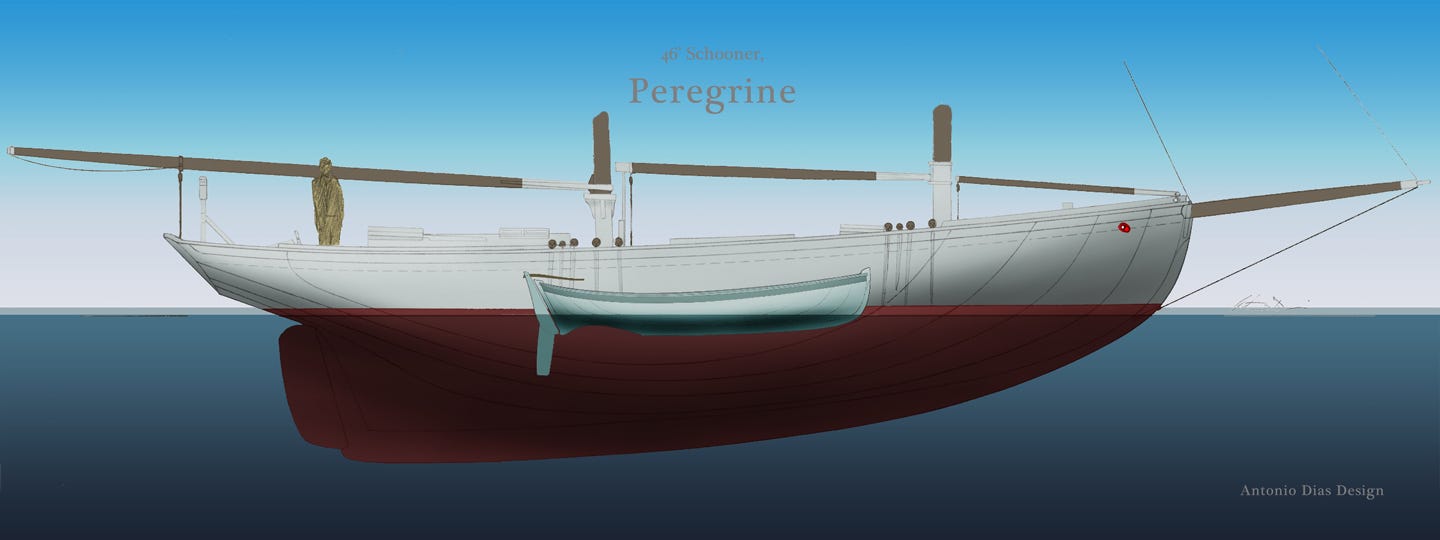Peregrine, a pilgrim. Not the Thanksgiving type, a traveler, a wanderer. Traveling with a purpose, bring something somewhere and find something to take on to the next port. We tend to think of this as a mercantile transaction, but there are other things we might carry besides a cargo.
What if we carry a skill, a practice? What if the crew’s skills are the cargo? I’m reminded of Guilds. Not the full-blown institution, but the basic structure. One works up through levels of training and work experience to become a Master. The term denoting how one has mastered a skill and their own selves, not that they have control over others.
When I see this layout; an after cabin with room for a couple or a single person and a guest; a hold with standing headroom under the large hatch; and a fo'c'sle with room for two more; it echoes an old pattern, officers aft, cargo amidships, and crew forward. This is a classic layout for vessels from this size on up to the largest ships. It’s been the setting for a rigid hierarchy and extreme exploitation. But must it be so?
I see some fresh possibilities.
Guilds, once the system had congealed into just another way to quantify life, came to embody exploitation and commercialization. That was not always true. We can find examples from Medieval Japan and Europe. At times when there was a purpose behind them beyond greed and lust after power. When people saw the ability to do a complex task well as a responsibility, an expression of gratitude, a way to repay a debt to creation itself.
In such a system a Master is responsible for those coming up under their care. An apprentice trades eagerness and youthful energy for a chance to be exposed to experience and perhaps wisdom. A Journeyman – we’ll stick to this old term but not to imply the gender of its practitioner – owes both the Apprentice and the Master. The Master for their training them and the Apprentice as a way to pay off their debt to the future. All their lives are entwined. Their days spent dedicated to a practice and to the communities they serve.
Within this attitude I can see Peregrine as a way to take such a practice “on the road,” or, should I say, to sea. A Master traveling with a Journeyman, someone deepening their skills, still learning, but able to help teach others. They take on local Apprentices. They practice their skill for the benefit of the communities that take them in.
To me, an obvious choice would be boat design and building. But there are countless other skills and practices that could travel aboard such a vessel.
The Master lives aft. The Journeyman, of whatever gender, forward. This apportioning fulfilling the differing requirements of different ages. A more settled existence aft along with the responsibility to navigate the craft at sea and steer the program on land. A more physically demanding space forward, but with the advantage of some privacy. A life forward bound to a Master for now and ultimately to how they are able to grow to meet their own fate. This reality reflected in their positions. One cannot do without the other. There’s an equality in that.
They would load a cargo for a passage. Unload on arrival. The hold would then be free to act as a floating class-room/work-room. Their activities might spill out onto the shore. There might be a building nearby they could use, or simply a field….
Such a craft would announce its intentions by its form, carrying its meaning along with a promise to share its values with those whose lives intersect their course.
Having gathered a fresh cargo, Peregrine and her crew move on….
At some point our Journeyman finds a place to settle. Or builds their own craft and sets off as a newly-minted Master in their own right. An apt Apprentice, graduating from shore to fo'c'sle, rounds out the new vessel’s crew.
Quoddy Light, a handy sail and oar tender, lies alongside. Built in a barn by the shore. Set-up beside another boat or two destined to remain when Peregrine sails on, lasting talismans of their visit. Along with the use these will provide the community, the barn-turned-shop might continue to attract people to a place where skills and needs intersect.
Peregrine is one in a series of preliminary designs I’ve laid down as focal points around which we may begin to imagine other ways to live that draw from historical vernacular sources and attempt to bridge the gap between where we find ourselves and where we might go if we are to begin to take seriously the changes we need to make if we are to forge more viable ways of living.









